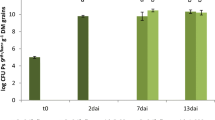Summary
Root-colonizing pseudomonads capable of inhibiting seedling winter wheat (Triticum aestivum L.) root growth in an agar seedling bioassay also significantly inhibited wheat root growth in vermiculite; however, the inhibitory trait is quite labile in laboratory culturing. The extent of inhibition in both the agar and vermiculite medium depended on inoculum level. These pseudomonads were found to produce a toxin capable of inhibiting growth ofEscherichia coli C-la andBacillus subtilis. Field isolates that strongly inhibit growth of indicator bacteria also inhibited root growth. Toxin production by the bacteria appeared necessary for inhibition of root growth and indicator bacteria as toxin-negative (TOX−) mutants no longer inhibited either. Antibiosis towardsE. coli as well as wheat seedling root inhibition in agar was reversed by L-methionine, providing further evidence that a toxin, produced by these organisms, is involved in growth retardation.
Similar content being viewed by others
Literature cited
Bennett R A and Lynch J M 1981 Bacterial growth and development in the rhizosphere of gnotobiotic cereal plants. J. Gen. Microbiol. 125, 95–102.
Bowen G D and Rovira A D 1961 The effects of microorganisms on plant growth. Plant and Soil 15, 166–188.
Brian P W 1957 Effects of antibiotics on plants. Annu. Rev. Plant Physiol. 8, 413–426.
Brown M E 1974 Seed and root bacterization. Annu. Rev. Phytopathol. 12, 311–331.
Cochran V L, Elliott L F and Papendick R I 1977 The production of phytotoxins from surface crop residues. Soil Sci. Soc. Am. J. 41, 903–908.
Darbyshire J R and Greaves M P 1971 The invasion of pea roots,Pisum sativum L., by soil microorganisms,Acanthamoeba palestinensis (Reich) andPseudomonas sp. Soil Biol. Biochem. 3, 151–155.
Elliott L F and Lynch J M 1984 Pseudomonads as a factor in the growth of winter wheat (Triticum aestivum L.). Soil Biol. Biochem. 16, 69–71.
Elliott L F and Lynch J M 1985 Plant growth-inhibiting pseudomonads colonizing winter wheat (Triticum aestivum L.) roots. Plant and Soil (In press).
Gasson M J 1980 Indicator technique for antimetabolite toxin production by phytopathogenic species ofPseudomonas. Appl. Environ. Microbiol. 39, 25–29.
Granada G A and Sequeira L 1983 Survival ofPseudomonas solanacearum in soil, rhizosphere and plant roots. Can. J. Microbiol. 29, 433–440.
Kloepper J W and Schroth M N 1981 Plant growth-promoting rhizobacteria and plant growth under gnotobiotic conditions. Phytopathology 71, 642–644.
Kloepper J W and Schroth M N 1981 Relationship of in vitro antibiosis of plant growth-promoting rhizobacteria to plant growth and the displacement of root microflora. Phytopathology 171, 1020–1024.
Kloepper J W, Schroth M N and Miller T D 1980 Effects of rhizosphere colonization by plant growth-promoting rhizobacteria on potato plant development and yield. Phytopathology 70, 1078–1082.
Leben C 1983 Association ofPseudomonas syringae pv.lachrymans and other bacteria pathogens with roots. Phytopathology 73, 577–581.
Norman A G 1959 Inhibition of root growth and cation uptake by antibiotics. Soil Sci. Soc. Am. Proc. 23, 368–370.
Patel P N and Walker J C 1963 Relations of air temperature and age and nutrition of the host to the development of halo and common bacterial blights of bean. Phytopathology 53, 407–411.
Rouatt J W and Katznelson H J 1961 A study of the bacteria on the root surface and in the rhizosphere soil of crop plants. J. Appl. Bacteriol. 24, 164–171.
Sands D C and Rovira A D 1970 Isolation of fluorescent pseudomonads with a selective medium. Appl. Microbiol. 20, 513–514.
Schroth M N and Hancock J G 1982 Disease-suppressive soil and root-colonizing bacteria. Science 216, 1376–1381.
Suslow T V 1982 Role of root-colonizing bacteria in plant growth.In Phytopathogenic Prokaryotes, Vol. I. Eds. M S Mount and G H Lacy, Academic Press, N. Y. pp 187–223.
Suslow T V and Schroth M N 1982 Role of deleterious rhizobacteria as minor pathogens in reducing crop growth. Phytopathology 72, 111–115.
Weller D M and Cook R J 1983 Suppression of take-all of wheat by seed treatments with fluorescent pseudomonads. Phytopathology 73, 463–469.
Author information
Authors and Affiliations
Additional information
Contribution in cooperation with the College of Agric. Res. Center, Washington State Univ., Pullman, WA 99164. Scientific Paper No. 6837.
Rights and permissions
About this article
Cite this article
Fredrickson, J.K., Elliott, L.F. Effects on winter wheat seedling growth by toxin-producing rhizobacteria. Plant Soil 83, 399–409 (1985). https://doi.org/10.1007/BF02184452
Received:
Revised:
Issue Date:
DOI: https://doi.org/10.1007/BF02184452




